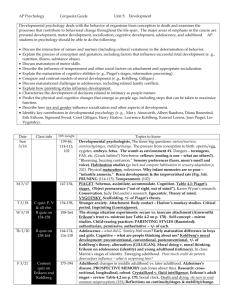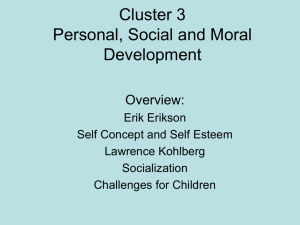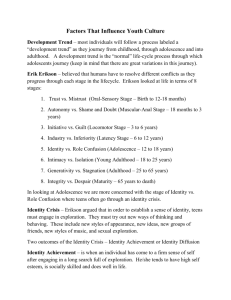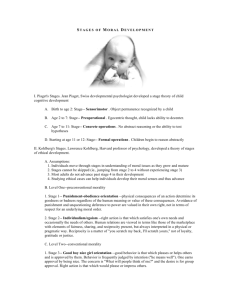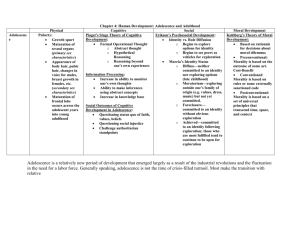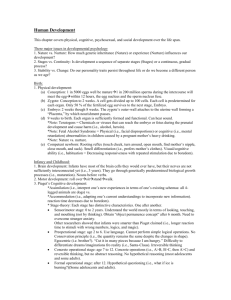Developmental Psychology
advertisement
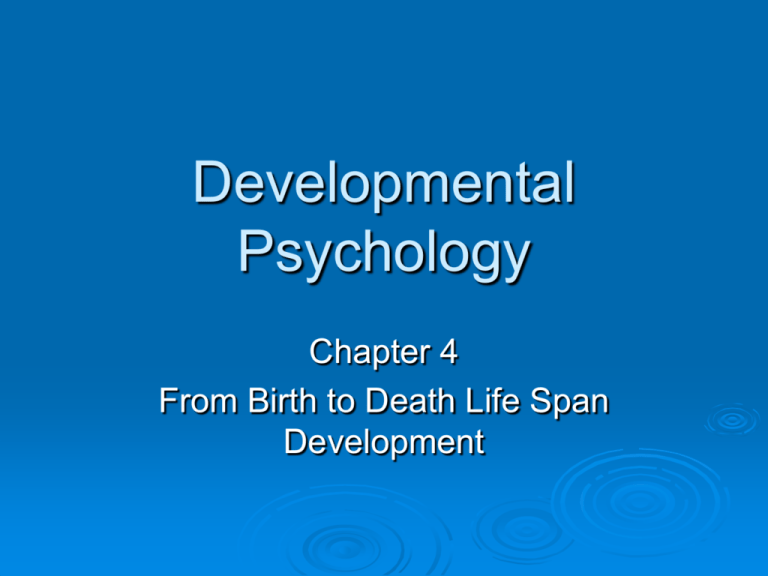
Developmental Psychology Chapter 4 From Birth to Death Life Span Development IX. Developmental Psychology (7–9%) Life-Span Approach Research Methods (e.g., longitudinal, crosssectional) Heredity-Environment Issues- Nature vs. Nurture Developmental Theories- Piaget, Freud, Erikson, Dimensions of Development: Physical Cognitive- Piaget Social Moral-Kohlberg, Gilligan Sex Roles, Sex Differences Postpartum Depression http://www.healthatoz.com/healthatoz/Atoz /common/standard/transform.jsp?requestU RI=/healthatoz/Atoz/dc/caz/ment/depr/post part.jsp Erik Erikson Personality theorist Student of Freud Built on Freud, found that Early childhood important for development of personality (Life Span approach) Supported structure of the ID, Ego and Superego- unconscious drives Believed that the main them in life was quest for identity Erikson and Identity Formation Identity is the major core of personality Identity is: a stable image of the relation between the self and the social world. Major psychological events (Dilemmas) occur in typical life and can be anticipated. “We all face predictable psychological conflicts as we develop.” Identity Formation is a life long process Has 8 stages One built on the other Erikson 8 Stages Each stage has a main a developmental task and some developmental milestones that must be accomplished to progress. Crisis and conflicts are inherent in each stage Each stage has demands and possibilities Erikson Stages Stage One: first year Trust vs. Mistrust (secure and insecure attachments) Stage Two: 1-3 years Autonomy vs. shame + doubt Stage three: 3-5 years Initiative vs. guilt Stage four: 6- 12 years Industry vs. Inferiority or Adequacy vs. Inadequacy Stage five: Adolescence: Identity vs. Role Confusion Stage six: Young Adulthood: Intimacy vs. Isolation Stage seven: Middle Adulthood: Generative vs. Stagnation Stage 8: Late Adulthood: Intimacy vs. Despair Adolescence Identity vs. Role Confusion Turbulent period, culturally defined Between childhood and Adulthood Physical Development Puberty Sexual Maturation Developmentally- adolescents are questioning: • • • • Attitudes “Who am I” Sometimes there is role confusion Conflicting roles: student, friend, athlete, worker, son… Adolescent- high emotion “Romeo and Juliet syndrome” Rousseau suggests three features: Instability and emotional conflict-caused by biological maturity “He becomes deaf to the voice he used to obey…he is a lion in a fervor, He distrusts his keeper and refuses to be controlled.” Diversity of Identity: Adolescents have multiple identities. Ethnic Identity Puberty-Biological Event Girls- 9-12 years old, begin Boys- 11-14 years Hormonal changes Cause rapid physical and sexual maturity Immature- social experience, intellectual and knowledge Identity Formation- puberty- “Time to begin a new self image” Adolescence transition Adulthood transition- Responsibility for oneself Independent decisions Financial independence Early and Late Maturation Bodily awareness concerns Timing of puberty may cause dissatisfaction over body Early maturation for boys is seen positive in society (seen as athletic, self assured…) Girls seen as less prestige Poor self image.. (not in middle school) Problems of Childhood Normal Problems Overprotection Sibling Rivalry Childhood Rebellion Divorce • Delayed speech • Telegraphic speech • Stuttering Autism Toilet Training disturbances Feeding Disturbances • Overeating • Anorexia Nervousa • Pica Learning Disorders • Dyslexia • ADHD Serious Problems Speech Disturbances Conduct Disorders Autism Behaviors: Temper tantrums Parroting back = Echolalia Repetitive Actions- rocking, flapping arms Sensory blocking- non responses Sensory spinout- watching faucet drip Causes of Autism Congenital defects in brain Symptoms occur before year 1 old Brains are larger than normal 25% approach normalcy Treatment helps- behavior modification Ivar Lovaas is a pioneer in the field Shaped behavior through rewards and punishment Child Abuse: Defined- physical or emotional harm caused by violence mistreatment or neglect Widespread- 3.5-14% abused by parents2million children physically abused in US/year Parents have high level of stress- causes more abuse Early Maturing Girls May force premature identity formation Treated as an adult too early Creates distorted sense of self Date sooner More independent More active in school In trouble at school Early sex experiences Parents and Teens David Elkind (researcher) Hurried Adulthood parents push kids too much Causes too much stress Parents affect Identity Formation: sometimes creates- conflict Dating, sex, substance abuse, freedom Parents give up should be authoritative- don’t give in or Adolescent Perceptions Elkind Imaginary Audiences: teens are preoccupied by imagining audiences Concerned that they are being watched Affects behavior Kids try to control outside impressions Autism: “Rain Man” Children in own thoughts Fantasies Private impulses Extreme isolation Affects 1 in 2500 4 times more boys than girls No interest in other people Not affectionate Adolescents and Peer Group Peer group People who share similar Status Security-identity Social Network During adolescence there is increased identification with peer group Conformity peeks Group pressure can shut down personal growth Foreclosure: Close identification with a peer group and or conformity can Shut Down personal Growth = Foreclosure Is it ok to loot during a riot? Kohlberg Link to good web site Kohlberg, who was born in 1927, grew up in Bronxville, New York, and attended the Andover Academy in Massachusetts, a private high school for bright and usually wealthy students. He did not go immediately to college, but instead went to help the Israeli cause, in which he was made the Second Engineer on an old freighter carrying refugees from parts of Europe to Israel. After this, in 1948, he enrolled at the University of Chicago, where he scored so high on admission tests that he had to take only a few courses to earn his bachelor's degree. This he did in one year. He stayed on at Chicago for graduate work in psychology, at first thinking he would become a clinical psychologist. However, he soon became interested in Piaget and began interviewing children and adolescents on moral issues. The result was his doctoral dissertation (1958a), the first rendition of his new stage theory. Kohlberg Moral Development Questions of conscience solidifies during adolescence Kohlberg- said- we learn moral values through thinking and reasoning He posed dilemmas to study kids Found- 3 levels of moral development based on reasoning 3 levels of Kohlberg Pre-Conventional- Moral thinking result of consequences Punishments and rewards Exchange of favors Conventional Level- moral thinking - based on desire to please others Or to follow accepted rules and values level- moral thinking based on self accepted thinking (mature) Post-Conventional Kohlberg-6 Stages People advance through stages differently many don’t reach the end. Stage 1-2 (Pre-conventional) young children and delinquents Stage 3-4 (Conventional) group oriented morals Older children and most adults Stage 5-6 (Post Conventional) Self directed morals- higher principles 20% of Adult population Higher principles Gilligan Moral Development CAROL GILLIGAN Link 1936-Current She is currently a Professor at the Harvard Graduate School of Education and a principle investigator on numerous studies of girls' and women's development. In 1970, Gilligan was a research assistant for Lawrence Kohlberg. In outrage and despair of the lack of attention given to women and girls in psychological research, she began to study and research women's development. During the past 20 years, Gilligan has contributed to research on adolescence, moral reasoning, and conflict resolution. She is best known for her book called In a Different Voice: Psychological Theory and Women's Development. Gilligan and Moral Development Justice or caring Found that caring about others or concern for others = moral development Boys look for justice Girls look for solution for all parties Outline Both Gould and Levinson and compare to Erikson Gould Levinson Roger Gould Development Patterns “I started my academic psychiatric career as the head of the U.C.L.A. outpatient and community psychiatry department. That’s where my lifelong focus on normal adult development began. I have written papers and textbook chapters as well as a book for the general public (Transformations, Growth and Change in Adult Life) based on research that I and my colleagues did on the predictable sequence of changing patterns and preoccupations during the adult years.” Gould’s Adult Development Patterns Age 16-18 Escape from dominance Age 18-22 Leaving the family Finding substitutes for family- closer relationships Age 22-28 Building a workable life Escape from parents Seeking competence <accomplishment> Reaching out to others <intimacy> Togetherness Ages 29-34 Crisis of questions Minor life crisis Serious questioning of what life is all about Is this it? Confidence waivers Extra marital affairs + divorce occur commonly Gould Continued Age 35-43 Crisis of Urgency Realization of reality of death Only limited years More desire for success – goals/career Generativity- (the desire to leave a legacy) • Nurturing, teaching, serving others- helps alleviate Age 43-50 Attaining Stability Calm acceptance of Fate “The die is cast.” Appreciation of family Age 50 and up Mellowing Savor life Les concern for glamour, wealth, accomplishment, abstract growth Levinson: Midlife Crisis 5 periods of transition People in these periods express concerns about identity, work and relationships Begins ages 37-41 Instability, anxiety, change Last chance to achieve goals Midlife Basics Menopause Hormone depletion Estrogen drops Causes fatigue, hot flashes, anxiety, irritability, depression Andropause “Empty nest” reduction of testosterone 6 elements of Well-being during Adulthood Self Acceptance Positive Relations with others Autonomy (personal freedom) Environmental mastery A purpose in life Continued personal growth Kubler-Ross Death and Dying Web site: Dr Elisabeth Kübler-Ross pioneered methods in the support and counseling of personal trauma, grief and grieving, associated with death and dying. She also dramatically improved the understanding and practices in relation to bereavement and hospice care. Her ideas, notably the five stages of grief model (denial, anger, bargaining, depression, acceptance), are also transferable to personal change and emotional upset resulting from factors other than death and dying. Bereavement and Grieving

